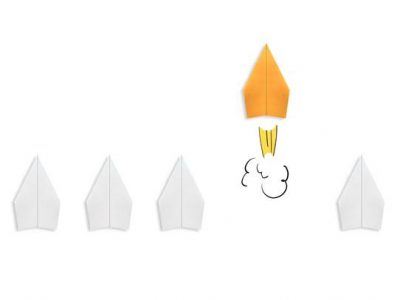
Innovation isn’t the goal of your business, it’s a side effect. Stop innovating and start talking to customers.
By Scott Case, CEO Upside Business Travel & Founding CTO Priceline.com
The one word you should remove from your vocabulary immediately is innovation.
Yeah, that’s right. I said it.
Why?
Innovation is overused. Nobody knows what it means anymore, yet everybody’s after it. Innovation has become a facade for, frankly, pretending to make change.
Therefore, I declare that innovation is BS.
Now, before you get all twisted up with my stance, know this—I’m not against inventing new solutions to solve problems or exploit opportunities. Far from it. I’ve spent a career sparking change and turning convention on its head by any means necessary to make this world a better place. I just don’t think most people are talking about innovation in the right way. I’m here to set the record straight.
The conventional idea of ‘innovation’ isn’t working. You can’t just make an incremental change to an existing product and call it innovation. That is not a path to real progress. You can’t reliably or consistently develop new services from scratch without having a basis for the ideas in the first place. If you feel like it’s time to do something different but you don’t know where to start, here’s how to think differently, and truly innovate.
Customer or Die
Day-to-day use of digital technologies and smart software have led to a profound power shift from the companies that sell products and services to the customers that buy them. If your company’s strategy isn’t centered around the customer, your company will eventually fail or be absorbed.
Companies like Amazon, Google, Apple, Baidu, Alibaba, and others keep raising the bar for customer expectations – even if you don’t directly compete with those companies. In the end, customer experience is the hill that companies will live or die on. This shift is shaking up every industry, producing a new and different set of winners and losers. Longtime incumbents will be knocked from leadership positions, and new companies will emerge with modern tech stacks and new business models that can quickly adapt to changing customer expectations.
No matter your industry, I believe that shifting the customer to the center of everything you do is what it means to truly innovate.
Further, for those of you thinking, “but what about creating something that is entirely new that the customer doesn’t know they want/need?” I am skeptical of this possibility. It is nearly impossible to invent something truly and completely novel that isn’t built on some category of challenge customers have. Almost everything is either an extension or expansion of some job the customer already needs or wants done. .
I challenge you to comment below with any example you believe is truly a new product that didn’t have a customer problem behind it.
Ask the Right Question
What problem are you solving for your customer?
Not what solutions do you have that you can try to market to them.
It’s remarkable how many CEOs and leaders of organizations have no idea what customer problem they are solving for. This should be the first and easiest question for them to answer. However, I’ve learned it’s not only universally the hardest—it’s also the most important.
My challenge to you: take out a piece of paper and write down what problem you are solving for your customer. If you can’t do that in 60 seconds with real clarity, go back and do your homework on the “who” and “why” behind your business.
Make it a Habit
Whether you sell directly to consumers or to enterprises, 100% of these “users” have new and changing expectations for how the products they use should work.
Embrace that reality.
At Upside, we’ve built our company around a constant customer “curiousness.” Here are some of the tactics we use:
In-Depth Interviews
Every quarter we speak with a handful of prospects and customers about who they are, what business they’re in, and why they do what they do. This helps us keep a regular pulse on who our clients are individually and the context that they operate in. We’re intentional about focusing exclusively on understanding the individual and their expectations, leaving Upside out of the conversation as much as possible as to not bias our takeaways and stick to our goal: understand the customer.
Feedback Loops
Every few weeks, we send prototypes of our newest features to customers. Things they’ve never heard of or experienced. We get direct feedback from the people who use our products, and we improve before we roll out changes to the masses. We also have a team whose entire job is to make sure our clients are more successful as a result of using our services. Upside’s Client Success Managers regularly check-in with clients, and serve as advocates to our product teams as well as amplifiers to our clients.
Future is at a desk near you
We know the future is iminent, so we place value on the trends and insights unearthed by team members earlier in their careers. They have grown up with more seamless technology than we have. They are the future generation of decision makers for all products, and are being influenced by the trends we are unaware of and expectations we can’t even begin to fathom. Frequent communication with the next generations within and outside of our organization helps us future-proof the customer expectations of tomorrow.
It’s impossible to drive innovation if you don’t know who your customer is or what the future holds for them. Period. Here’s how your organization—no matter the size or industry—can get after it.
Advice for Startup Executives
Feedback loops should be a founding principle of every business. They exist to organically feed “innovation.” With an ever-changing landscape, it is time to adapt by building an organizational culture around customer expectations. Here are some ways you can do it and be successful:
- Get out of the building. Talk to prospects and customers as often as you can and at least once a quarter.
- Pay attention to the “dog that didn’t bark.” Focus on your detractors, not just your promoters. Try to understand the context of their struggle by getting to know who they are and what they’re trying to achieve.
- Become your own customer. Eat your own dog food, then eat your competitors’ dog food, too. In other words: be a customer of your service and your competitors to experience the “value” for yourself.
Advice for Executives at Larger Companies
Revisit your own expectations. Your $1,000 phone updates itself and gets better over time. You tap a button to hail a ride. Your car breaks for you when it senses danger. Robotic vacuums clean your floors. Next-day delivery of everything from diapers to diamonds is the status quo. Your customers have the same “on-demand” expectations when it comes to you.
Take a look inside your own enterprise. The SaaS tools your employees use aim to gain efficiency and leverage over the parts of your organization that aren’t strategic. Those SaaS tools are changing the expectations of your employees, too. If you’re not adopting new technologies internally to reduce risk and complexity, how can you lead the charge externally to your own customer base?
“Interview” your current employees. Understand how they are engaging with Amazon, Apple, Google and others that are setting the bar. Learn from them on how to apply those expectations to your company.
The Bottom Line
Getting closer to your customers will change the culture of your organization. And, as a result, spur real innovation.
“Good leaders organize and align people around what the team needs to do. Great leaders motivate and inspire people with why they’re doing it. That’s purpose. And that’s the key to achieving something truly transformational.” Marilyn Hewson, CEO Lockheed Martin
I believe the “why” for any team should be centered around the customer. So, you tell me — what do your customers want and what are you doing about it?
Scott Case regularly shares bold ideas. Connect with him on LinkedIn if you’re working to make a dent in the universe.
Follow UConn Werth Institute on LinkedIn.
Scott Case hosts a speaker event on his UConn experience, startups, and finding great mentors on Tuesday, October 1st, 2019 at 7pm at the Student Union Theater.


